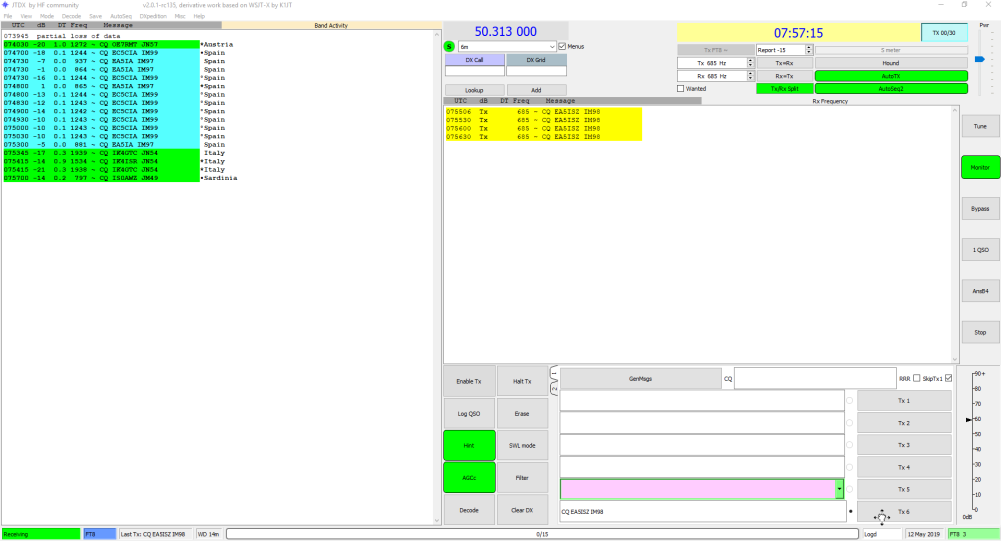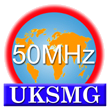FT8
FT8, love it or loathe it you cannot ignore it. FT8 has been the mode of choice for many operators on all bands from 160m upwards. Castigated by some as simply two computers in contact, a degree of human input is nevertheless required. This is particularly true at 6m where knowing how propagation works at these frequencies and where and when to point your beam can really affect the sort of ‘DX’ that you work. FT8 has dominated 6m in recent years; perhaps unsurprisingly when the possibilities become apparent.
So what is it? Devised by Joe Taylor K1JT it is a weak signal mode where computer algorithms are able to dig extremely weak signals out of the background noise and recover useful information from the transmitted signal. This is typically a call-sign, 4 digit locator square and an indication of the strength of the station being worked in dB. Typically something between +25 (very strong) and -25 (very weak). Additionally, the programme will send 73 and acknowledge receipt of the signal report. This is sufficient to qualify for a valid QSO although the niceties of name QTH etc are missing.
There is absolutely no doubt that it is possible to work DX that would have been impossible via the traditional modes of SSB and CW. The mode has distinct advantages for those unable to run the legal limit to a large array. Even 10 Watts to a vertical or small Yagi is capable of surprising results. This short brief is not intended to go into the detail of how to set up your station to use FT8, for that this link should tell you all you need to know: https://www.g4ifb.com/FT8_Hinson_tips_for_HF_DXers.pdf The link will also point you to downloads for the software itself. Ensure that you download the latest release as earlier variants are not necessarily compatible!
 There are three main programs, any of which will achieve the same outcome: WSJT-X, JTDX and MSHV. Which you choose is down to personal preference. My advice would be to use one until you become familiar with it and then try the others. They are sufficiently similar that a second learning curve will be very short. A swift Google for FT8 will bring you a lot more information if you have the time to sift through it all. The example shown here is JTDX.
There are three main programs, any of which will achieve the same outcome: WSJT-X, JTDX and MSHV. Which you choose is down to personal preference. My advice would be to use one until you become familiar with it and then try the others. They are sufficiently similar that a second learning curve will be very short. A swift Google for FT8 will bring you a lot more information if you have the time to sift through it all. The example shown here is JTDX. It will take a short while to become comfortable with the software but it is fairly intuitive and there is plenty of help available both within the software via drop down boxes and also out there on the net, especially via YouTube.
There are two main frequencies used for FT8; these are 50.313 and 50.323. 50.313 is the ‘work horse’ frequency where most of the general operation takes place, especially within your own continent. Here it is largely immaterial which transmit sequence is used as the opposite sequence is always used by your QSO partner. If you are in Europe it would make sense when calling CQ to use (Tx 00/30) as most US and Asian stations will transmit in the odd sequence.
If you are in Europe, 50.323 should only be used for QSO’s outside your continent. Europe transmitting in the first sequence (Tx 00/30) and stations wishing to work into Europe transmitting second sequence (Tx 15/45)
The recommendations for intercontinental working to and from Europe can only work for those in Europe and those wishing to work Europe. They cannot apply to traffic to and from other areas. However, by ensuring Europe remains in a fixed time sequence it will ensure minimum QRM for both those in Europe and those attempting to work Europe. For those outside Europe wishing to work other non European areas, then they remain free to use whichever sequence is deemed appropriate. If the recommendations are followed, then within Europe the ‘odd’ sequence will only be occupied by stations from outside Europe benefitting both the EU and DX end of the contact.
Taking South Africa as an example; to call Europe you will always be best advised to use the second/odd period on both 50.313 and 50.323. As stated above, 313 is used for both local and long haul traffic so it may prove difficult to break through QRM on particularly active days. 323 is generally much quieter and the great majority of EU stations avoid transmitting in the second/odd sequence. Australia and Oceana should also follow this advice to maximise the chances of a successful contact. In all cases, if you can let the rest of the world be aware of a possible opening to your area or just the fact that you are listening on a site such as ON4KST chat, it will alert everyone and will ensure beams are pointing in the right direction.
FT4 is a variant of FT8 and is intended for faster QSO’s (typically around half the time taken by FT8) and is therefore much more suitable for contest operation; the trade off for this increased speed is reduced sensitivity. It uses four tones rather than the eight used by FT8 and has a recommended frequency of 50.318. At present, UKSMG do not accept contest entries for FT8/FT4 QSOs. This is largely intended to retain the cut, thrust and excitement generated by a SSB/CW contest as well as to retain a relatively even playing field.
Finally, bear in mind that there are other well used digital modes and that these have not been supplanted by FT8 although it may seem that way. For example, JT65 has a little more sensitivity than FT8 and is probably a better option over particularly marginal paths where the QSO is by prior arrangement. More recently, Q65 is a new data mode intended for very difficult paths. At present it is being used by relatively few but it may be worth trying. For further details see here.
EA5NW, April 2023
EA5NW, April 2023
© ℗ UKSMG Unless otherwise stated, all content copyright UKSMG. This Web site is published on a strictly non-profit basis but please note that UKSMG is not a registered non-profit organisation. The opinions expressed are the opinions of the authors alone and not that of any associated organisations or employers or hosting Internet service providers. No material may be used in other media unless full credit is given to the UK Six Metre Group or the credited original source of the material.

